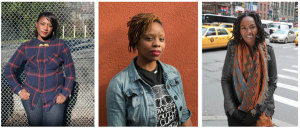Whether you first encountered #BlackLivesMatter recently on social media, heard the phrase from protestors on the streets, or listened to it coming out of the mouths of presidential hopefuls, the founders of the hashtag-turned-movement have been doing this for a long time.
Patrisse Cullors, Alicia Garza, and Opal Tometi reside in Los Angeles, Oakland, and in Brooklyn, New York, but their work is hardly static or even new. Aside from #BlackLivesMatter, the organizers continue to work in distinct — but parallel — initiatives to amplify the voices of less-heard populations, from undocumented immigrants to incarcerated youth.
As Fun Fearless 50 honorees who inspire us, Cullors, Garza, and Tometi spoke with Cosmopolitan about what inspires them to push for change — and challenge ideas about what change actually looks like.
#BlackLivesMatter might have been many people’s introduction to each of you and the work that you do, but can you all discuss your other work and what inspired you to come together?
Cullors: I’m actually the truth and reinvestment director at the Ella Baker Center for Human Rights,which is located in Oakland, California. My passion is really about looking at the impacts of policing on black communities in particular as well as the impacts incarceration has on black communities. I got into this work because I was deeply impacted by the police system and the world of incarceration. I witnessed my family members in and out of jail, I witnessed a lot of state violence, and this movement saved my life.
Garza: I am the special projects director for the National Domestic Workers Alliance and for the last 13 years, I’ve been organizing at the intersections of racial, economic, and gender justice.
Tometi: I am the executive director of the Black Alliance for Just Immigration, which is the country’s only national immigrant rights organization for black immigrants and African Americans. Being the daughter of Nigerian immigrants really drove me to do this type of work.
What does it mean to come together and to be organized, and what should that mean to people who are curious about your work?
Cullors: I identify as an organizer versus an activist because I believe an organizer is the smallest unit that you build your team around. The organizer is the person who gets the press together and who builds new leaders, the person who helps to build and launch campaigns, and is the person who decides what the targets will be and how we’re going to change this world. So the Black Lives Matter network is an organizing project and a network with 26 chapters across the [world] including in Toronto and Ghana. It’s what we’ve decided our contribution is to this movement, and the work is beautiful and powerful.
#BlackLivesMatter has often been characterized as a youth movement. What do you want to impart to young people about the possibilities of what your work does?
Tometi: It was really my younger brother who [is in his late teens] who inspired me to get involved in this kind of work. I’ve learned a lot from him and his life, and when Trayvon Martin was murdered and George Zimmerman was acquitted, he was the first person who came to my mind. This movement and the new tools that we’re using allows for new generations to get involved and see themselves as part of the change that’s possible in our country.
Garza: This moment has really been catalyzed by young people who stood up and decided that enough was enough in Ferguson, Missouri. And I think when we look around the country and we see what’s happening, we see young people taking risks, being courageous, and inspiring us to do better and to do more. What that means is that we have hope not just for our future but also for our present.
When the three of you were honored at the New York Women’s Foundation earlier this year, you entered and made everyone say “black lives matter” for at least one full minute. Why is saying that so huge?
Garza: Saying “black lives matter” both literally and figuratively restores people’s dignity. For us, #BlackLivesMatter is really a re-humanization project. It’s a way for us to love each other again, to love ourselves, and to project that love into the world so that we can transform it.
Why is structuring this movement as an intersectional one important to you, especially as women who identify in so many lines, whether that be as black women, as non-hetero, or as queer?
Cullors: Black women hold it down all the time and we have been the architects of the movement — not just this current one, but previous ones — since the beginning. So we decided very early on that we weren’t going to allow our stories and the stories of black women to be erased.
Tometi: I often think of Audre Lorde and her saying that we don’t live and we don’t fight for one specific struggle. We live intersectional lives and so I think that this movement has to reflect that. All of who we are, all of our dignity, and all of our brilliance.
Who are some leaders that inspire you?
Cullors: Assata Shakur.
Tometi: Denise Perry.
Garza: My mama.
Source : Cosmopolitan.com



